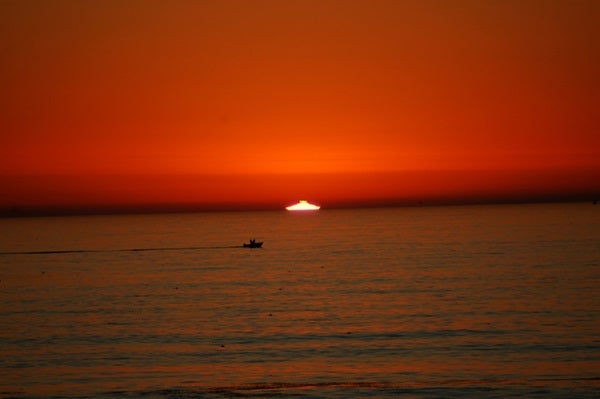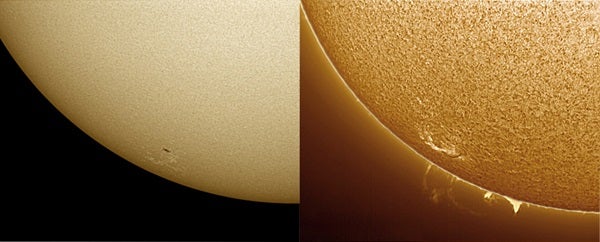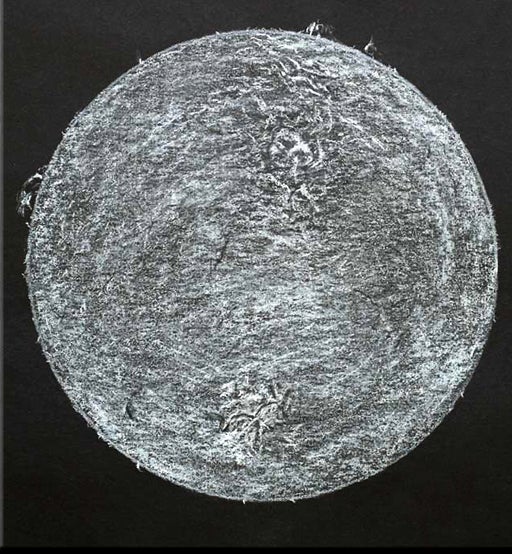This article originally appeared in the May, 2010 issue of Astronomy.
Many observers consider the Sun the ultimate celestial villain because it robs them of valuable telescope time. But look on the bright side (pun intended). The Sun is easy to find and offers plenty of detail. Plus, you’ll get great views through any size telescope, and capturing solar images takes little time.
Be safe, not sorry
The first item of business for any solar observer is eye safety. Make sure you use an approved solar filter from a reputable manufacturer. This isn’t something that you can make yourself out of shiny candy wrappers. High-quality solar filters remove infrared and ultraviolet radiation and allow only a small fraction of the Sun’s visible light through. Also, never use a solar filter that attaches to an eyepiece. A solar filter must cover the entire front end of your telescope. That’s where the light enters. If you need convincing, see Glenn Chaple’s “Observing Basics” column in Astronomy’s January 2010 issue.
Pick a viewing method
Actually, there is one way you can view the Sun without a filter: Use your telescope for solar projection. Observers who favor this method trace the Sun’s disk and any visible sunspots. This technique provides better positional accuracy over sketching freehand. Manufacturers classify solar filters by the wavelengths of light they transmit. The most popular are visible-light filters. As the name implies, these filters transmit visible wavelengths (at a much reduced level). Visible-light solar filters allow you to see sunspots, granulation (surface mottling), occasional faculae (small bright areas), and limb darkening. The next most-popular filter allows only light with a wavelength of 656.28 nanometers to pass through. That wavelength marks an emission of red light that occurs when an electron in a hydrogen atom drops from the third to the second energy level. Physicists labeled this emission Hydrogen-alpha (Hα), so you’ll need an Hα filter to see it. Hα observing allows amateur astronomers to view normally hidden solar features like the chromosphere (the layer beneath the visible surface) and prominences. Through these filters, solar flares appear as white regions on the Sun’s disk, and often such features change in mere minutes. The only reason Hα observing is less popular than visible-light observing is cost. Hα filters typically cost 10 to 50 times as much as visual ones.
View when conditions are best
In most locations, morning is the best time to observe the Sun. The daytime atmosphere is coolest then, so the movement of heated air produces less distortion that your telescope will reveal. This isn’t always the case, so be sure to test this general rule at your observing site. When I lived in El Paso, Texas, afternoon proved to be the best time to view the Sun. My house sat just west of the Franklin Mountains. In the morning, as the mountains heated up, the air above them became unstable. My most steady views, therefore, came after noon when the Sun stood in the western sky.
Draw!
Atmospheric stability allows you to observe the Sun’s rich details. You can do so visually, but there’s also a way you can capture solar details without being an astroimager. Try sketching the Sun. You don’t have to be an artist to produce a good image. Be happy with your work. You will improve. Sketching will make you a better observer. You must memorize small areas of detail before transferring what you’re seeing to paper. The more objects you sketch, the more honing in on small details will become part of your normal observing routine. As a practical matter, don’t make the circle that represents the Sun too large. The first few times I sketched the Sun, I used circles that barely fit on a large sheet of paper. Each one took forever to make! After a few of these marathon sessions, I settled on a circle approximately 3 inches (7.6 centimeters) in diameter. The best way to start sketching the Sun is to use pencils with dark, soft lead on white paper — and don’t hesitate to use your eraser. To capture the “not-sodark” areas around sunspots, some observers lightly smudge what they’ve drawn with a finger. For this technique, coarse-grade sketching paper seems to work best, as does lots and lots of practice. It’s OK to do some light touch-up work to fill in shaded areas after your sketching session as long as you don’t add details you didn’t see through the scope.
The same safety precautions to observe the Sun are in effect during solar eclipses. The only exception occurs during totality. First contact signals the eclipse’s start, but the real action begins at second contact as the Moon fully covers the Sun. In 1836, the English astronomer Francis Baily noticed a string of irregularly spaced, brightly lit points at the edge of the Moon just before totality. Now known as Baily’s beads, you can spot this phenomenon several seconds before and after totality. The beads are actually the last few rays of sunlight shining through valleys on the Moon’s limb. Immediately before totality, just before the last vestige of sunlight vanishes, the corona appears. Observers long ago dubbed the combination of one brilliant point of light and the round corona the “diamond ring.” View it once, and you’ll never forget it. At this point, remove any filters from your scope. The view is safe until the next diamond ring appears. After the first diamond ring vanishes, you may be able to glimpse the reddish chromosphere. This is a difficult observation because it lasts for only about a second, but it’s the only time you can spot the chromosphere without an Hα filter. Now and throughout totality, you may see large solar prominences with your naked eyes. Observers who have seen multiple total solar eclipses tend to remember each by the size of the largest prominences and by the corona’s overall shape. Take advantage of this view. The wispy outer atmosphere of the Sun is now in view. Even experienced eclipse-goers have no idea how the corona will appear prior to totality. It’s always a surprise. For a guide to the next total solar eclipse, see “Totality crosses Easter Island” in the March 2010 issue of Astronomy. Sun-watching offers something for everyone. You can follow sunspots in visible light, watch solar flares erupt in Hα, or chase eclipses halfway around the world. However you choose to observe it, the Sun will provide an ever-changing vista of high-quality views.












